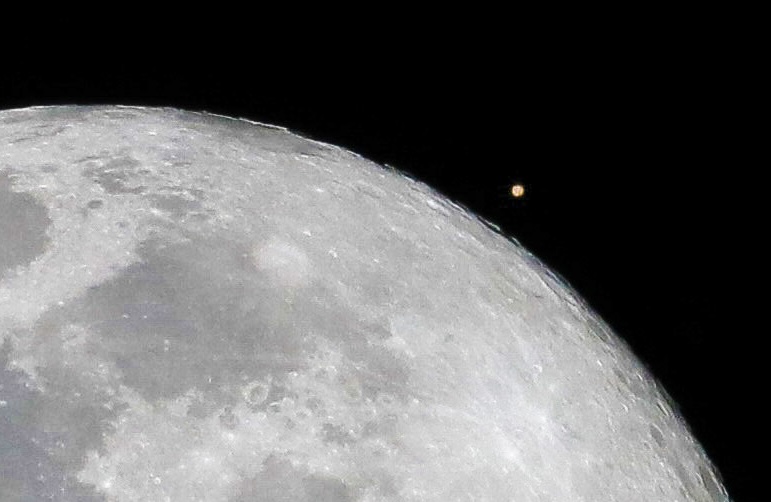
ARSTECHNICA.COM
There was a straight shot from Earth to the Moon and Mars last night
250x There was a straight shot from Earth to the Moon and Mars last night Even at its closest point to Earth, Mars looms 250 times farther than the Moon. Stephen Clark Jan 14, 2025 6:21 pm | 8 As seen from East Texas, Mars reappeared from behind the Moon at approximately 9 pm CST (10 pm EST) Monday night. Credit: Stephen Clark/Ars Technica As seen from East Texas, Mars reappeared from behind the Moon at approximately 9 pm CST (10 pm EST) Monday night. Credit: Stephen Clark/Ars Technica Story textSizeSmallStandardLargeWidth *StandardWideLinksStandardOrange* Subscribers only Learn moreI almost missed it. Amid a bout of prime-time doomscrolling, a social media post reminded me there was something worth seeing in the sky. Mars disappeared behind the full Moon for a little more than an hour Monday night, an event visible across most of North America and parts of Africa.So I grabbed my camera, ran outside, and looked up just as Mars was supposed to emerge from the Moon's curved horizon. Seen with the naked eye, the Moon's brightness far outshined Mars, casting soft shadows on a cold winter evening in East Texas.Viewing the Moon through binoculars, the red planet appeared just above several large partially shadowed craters at the edge of the Moon's curved limb. I quickly snapped dozens of photos with my handheld Canon 80D fitted with a 600 mm lens. Within a few minutes, Mars rose farther above the Moon's horizon. Thanks to the parallax effect, the Moon's relative motion in its orbit around Earth appears significantly faster than the movement of Mars in its orbit around the Sun.There are undoubtedly sharper images of Monday night's cosmic conjunction. I rushed to take as many pictures as possible with only a couple of minutes of preparation, so I didn't use a tripod. There are many wonderful astrophotographers with the skill and equipment to capture better views than I did. You can see the work of one of these astrophotographers, Andrew McCarthy, in this image from a 2022 lunar occultation.But I hope my experience conveys the accessibility of the sky's wonders if you know when and where to look.Scale and grandeurThe red planet is currently about 250 times more distant than the Moon. As of Tuesday, Mars is roughly 60 million miles (96 million kilometers) away, about as close as it ever gets to Earth. Mars reaches opposition, or its closest approach to our planet, on Wednesday night. This happens once every 26 months, and it always comes a few months after the ideal launch window for spacecraft traveling from the Earth to Mars.The most recent lunar occultation of Mars that was visible from the United States occurred on December 7, 2022. A handful of these events occur every few years around each Martian opposition, but they are usually only visible from a small portion of Earth, often over the ocean or in polar regions. The next lunar occultation of Mars visible across most of the United States will happen on the night of February 45, 2042. There are similar occultations of Mars in 2035, 2038, and 2039 visible in narrow swaths of South Florida and the Pacific Northwest. This photo was taken with a handheld Canon 80D and a 600 mm lens. Settings were 1/2000 sec, f/8, ISO 400. The image was cropped and lightly edited in Adobe Lightroom. The Moon also periodically covers Venus, Jupiter, Saturn, and the Solar System's more distant planets. A good resource on lunar occultations is In-The-Sky.org, which lists events where the Moon will block out a planet or a bright star. Be sure you choose your location on the upper right corner of the page and toggle year by year to plan out future viewing opportunities.Viewing these kinds of events can be breathtaking and humbling. In 2012, I was lucky enough to observe the transit of Venus in front of the Sun, something that only happens twice every 121 years.Seeing Mars, twice the size of the Moon, rising above the lunar horizon like a rusty BB pellet next to a dusty volleyball provided a perfect illustration of the scale and grandeur of the Solar System. Similarly, viewing Venus dwarfed by the Sun was a revealing moment. The worlds accompanying Earth around the Sun are varied in size, shape, color, and composition.In one glance, an observer can see the barren, airless lunar surface and a cold, desert planet that once harbored rivers, lakes, and potentially life, all while standing on our own planet, an oasis in the cosmos. One thing that connects them all is humanity's quest for exploration. Today, robots are operating on or around the Moon and Mars. Governments and private companies are preparing to return astronauts to the lunar surface within a few years, then moving on to dispatch human expeditions to the red planet.Plans to land astronauts on the Moon are already in motion, but significant financial and technological hurdles remain for a crew mission to put humans on Mars. But for a short time Monday night, it looked like there was a direct path.Stephen ClarkSpace ReporterStephen ClarkSpace Reporter Stephen Clark is a space reporter at Ars Technica, covering private space companies and the worlds space agencies. Stephen writes about the nexus of technology, science, policy, and business on and off the planet. 8 Comments
0 Commenti
0 condivisioni


